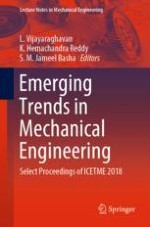2020 | OriginalPaper | Buchkapitel
Comparison of Various Types of Lubrication During Hard Turning of H13 Tool Steel by Analysing Flank Wear Using ANOVA
verfasst von : Anil Raj, K. Ramesha, Joel U. Sajan, Danish Mohammed Khan, U. A. Varshini
Erschienen in: Emerging Trends in Mechanical Engineering
Verlag: Springer Singapore
Aktivieren Sie unsere intelligente Suche, um passende Fachinhalte oder Patente zu finden.
Wählen Sie Textabschnitte aus um mit Künstlicher Intelligenz passenden Patente zu finden. powered by
Markieren Sie Textabschnitte, um KI-gestützt weitere passende Inhalte zu finden. powered by
